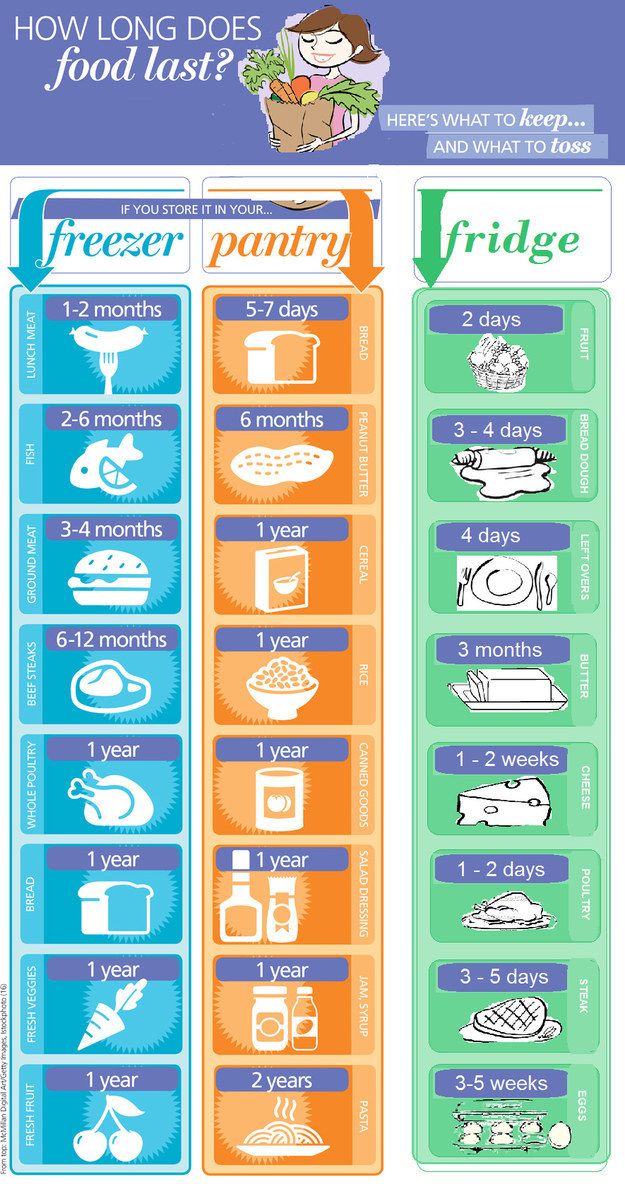How much to feed a baby leopard gecko
10 Baby Leopard Gecko Care & Feeding Tips for Beginners
Leopard Geckos are one of the most popular pet lizards in captivity, and rightfully so.
They have delightful personalities, simplistic husbandry requirements, and irresistibly cute faces! What’s not to love?
Whether you’re the proud new owner of your own Baby Leopard Gecko or you’re trying to learn as much as you can before you pick up or receive your new pet, you’ve come to the right place.
We’re going to cover the ten most important tips for taking care of and feeding your new Baby Leopard Gecko.
Once you nail down these guidelines, there’s not much more to it – just enjoy and bond with your Baby Leopard Gecko!
In This Article
1. Know What to Expect From Your Baby Leopard GeckoBefore we get into any specific care and feeding tips, it’s best to gain a solid understanding of normal and healthy Baby Leopard Gecko behavior!
For example, did you know that new Baby Leopard Geckos probably WON’T eat for the first week while they’re becoming acclimated to their new surroundings?
Or how about the fact that they eat their skin?! That’s right – if you see your Baby Leopard Gecko biting at itself or gulping down some unknown white, papery substance – it’s likely old skin!
Baby Leopard Geckos shed once or twice every week, and you likely won’t find the evidence.
It’s also expected that you may not see your Leopard Gecko move or explore much unless you’re a night owl.
Leopard Geckos are naturally active after the lights go out, and they tend to hide and sleep for most of the day.
Another reality that you should come to terms with is that Baby Leopard Geckos need live insects to grow and thrive.
You can buy the bugs at the pet store, online, or breed them yourself, but the fact of the matter is that you’ll have to be comfortable with having real crickets, grubs, and even roaches in your home on any given day.
Finally, while you may never encounter this freaky phenomenon, it’s essential to be aware of the fact that startled Leopard Geckos will “drop” their tail!
This is a defense mechanism used to distract predators while they make their escape. Don’t worry; most Leopard Geckos recover just fine and even re-grow their tail.
Now that we’ve covered all of the nitty-gritty potential drawbacks of Baby Leopard Gecko ownership, let’s move on to the more positive points:
- They’re so cute! Especially as babies.
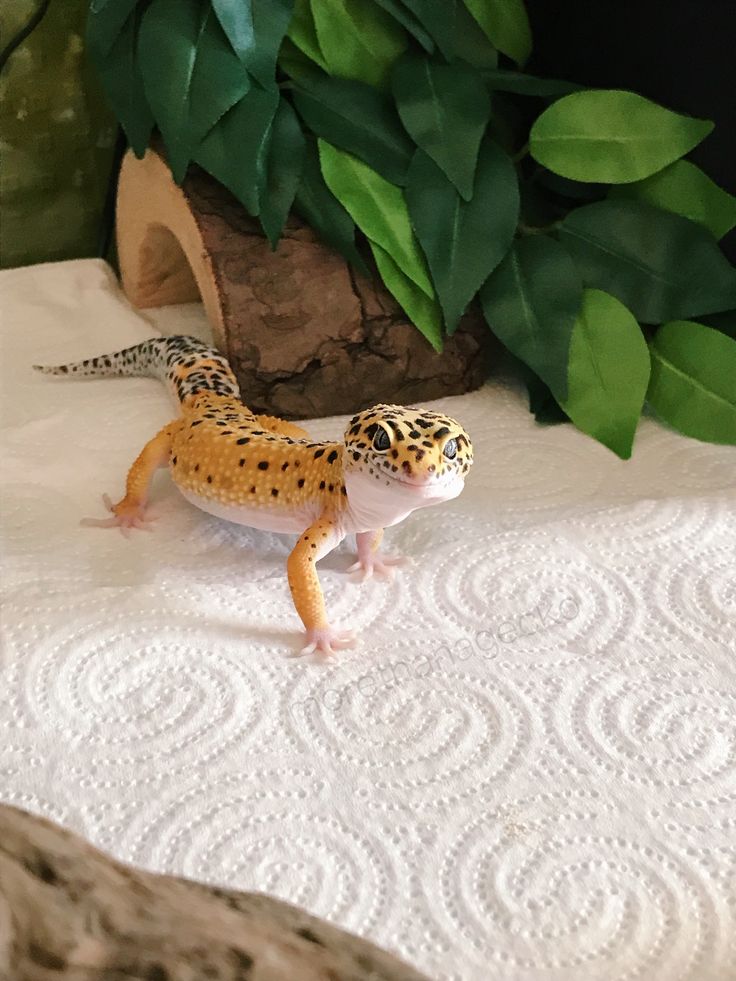
- There are several different morphs you can choose from (Albino leopard gecko is one of the most popular ones)
- Leopard Geckos that are handled often seem to enjoy interacting with humans.
- They stay reasonably small and don’t require a huge enclosure.
- Leopard Geckos don’t require expensive, elaborate set-ups or equipment.
- These friendly little guys rarely bite, and even when they do, it doesn’t hurt.
- Leopard Geckos usually go to the bathroom in one corner of their enclosure, making clean-up and maintenance a breeze.
As we mentioned above, when you bring your Baby Leopard Gecko home, it likely won’t eat for the first week or so.
Your Baby Leopard Gecko will be stressed out from the trip and new sights, sounds, and scents.
The best thing to do during this acclimation period is to leave him or her alone. There’s plenty of time for bonding after your baby has settled in!
We suggest you wait to start handling your Baby Leopard Gecko for at least seven days, or until you know it’s eating and pooping fine – whichever criteria takes the longest.
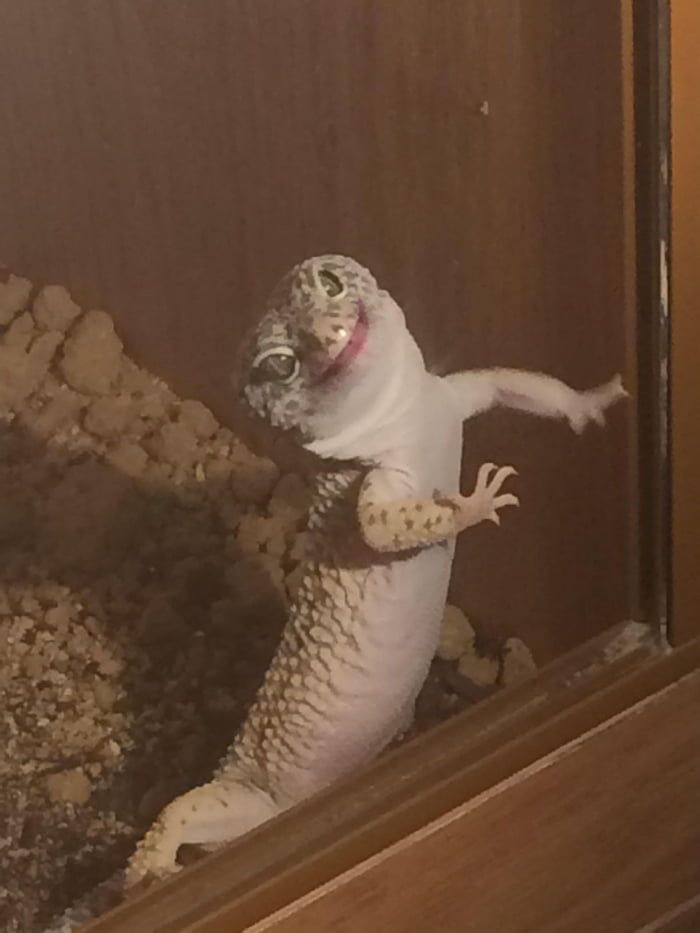
During this time, only open the enclosure to offer fresh water and food (only if it seems to go missing). Try to keep the room somewhat dark and as quiet as possible during this time.
We stress that you should NOT keep adding more bugs every day if they don’t seem to be disappearing. An excessive amount of insect activity in the habitat could stress your baby even more!
When you do start handling your Baby Leopard Gecko, take things slowly. Never try to grab or “catch” your Baby Leopard Gecko if it’s running from you – this could cause it to drop its tail.
While that isn’t a life-threatening situation, you will need to treat the tail base as an open wound, and your Baby Leopard Gecko will need to dedicate its biological resources to regenerating the tail instead of growing.
3. Set Up an Appropriate Enclosure for Your Baby Leopard GeckoYour Baby Leopard Gecko can start in a small 10-gallon aquarium or a plastic bin with at least 1. 25 square feet of floor space.
25 square feet of floor space.
Inside the enclosure, you should provide:
- At least three hides: one on the warm side, one on the cool side, and one humid hide.
- A shallow water dish that your Baby Leopard Gecko can’t drown in
- Rocks, logs, plants, and aquarium or terrarium decor, as desired.
Once your Baby Leopard Gecko reaches adulthood, it will need an upgrade to an enclosure with at least 2.5 square feet of floor space, like a 20-gallon long aquarium.
You should use a securely-locking lid on your Baby Leopard Gecko’s enclosure.
While they’re terrestrial and can’t climb glass, many crafty young geckos have devised ways to climb corners and terrarium decorations to reach the open top and escape.
Baby Leopard Geckos benefit from UVB lighting, but it’s not required.
If you don’t use a UV bulb over your Leo’s habitat, be sure to supplement their diet with calcium powder that includes Vitamin D3.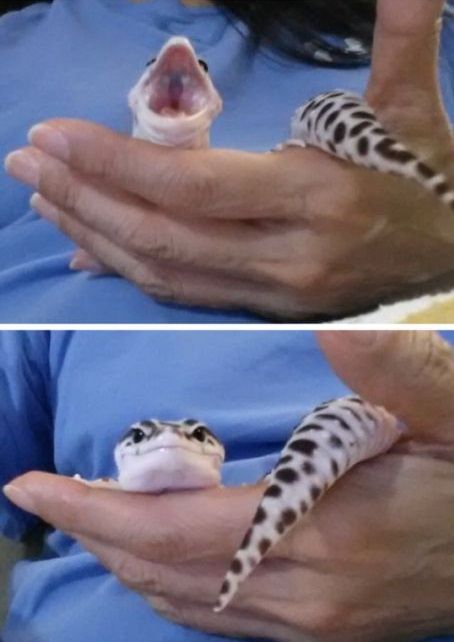
If you use lighting, be sure to hook up a timer set for 12 hours on and 12 hours off.
Finally, your Baby Leopard Gecko is going to need supplemental heat to digest its food and stay healthy.
4. Set Up a Temperature Gradient in Your Baby Leopard Gecko’s EnclosureAll captive reptiles benefit from a temperature gradient in their enclosure.
Creating a temperature gradient involves heating one side of the enclosure to a maximum ideal temperature; the hottest area on this side of the enclosure is known as the “basking spot.”
The temperature will gradually fall to a minimum ideal temperature on the other side of the enclosure, known as the “cool side.”
The middle of the enclosure should fall somewhere between the maximum and minimum ideal temperatures.
This temperature gradient allows your Leopard Gecko to control its own body temperature by using its environment, which is what ectothermic animals evolved to do.

| Baby Leopard Gecko Temperature Summary | |
|---|---|
| Basking Spot Temperature: | 90-95°F |
| Warm Side Ambient Temperature: | 80-90°F |
| Cool Side Ambient Temperature: | 70-80°F |
| Optional Nighttime Temperature Drop: | 60-74°F |
You can provide heat using any of the following depending on what works best for your set-up:
- Halogen light bulb
- Ceramic heat emitter
- Carbon filament heat projector
- Deep heat projector
- Heating cable
- Heating pad
- Reptile heat tape
Always use a thermostat when operating any heating element to mitigate risks like a house fire or overheating and killing your reptile.
At night, you can likely turn off all heating elements. Research indicates that ectothermic animals benefit from a drop in temperatures at night.
Many new Leopard Gecko owners may be tempted to use “reptile sand” that’s often explicitly marketed for Leopard Geckos.
The scary truth is that most commercially available “reptile sand” is very dangerous for your Baby Leopard Gecko.
Numerous Baby Leopard Geckos have passed away after ingesting too much of their loose substrate while hunting.
Unfortunately, the sand can cause an intestinal blockage, which is a death sentence. Sometimes surgery has been a successful treatment option, but even that comes with its risks.
Most Leopard Gecko veterans recommend these types of substrates to new Baby Leopard Gecko parents:
- Paper towels, non-glossy newspaper, or butcher block paper
- Tile
- Reptile sand mat
- Shelf liner
When your Baby Leopard Gecko grows up, you may want to consider one of the safe particulate substrates available because they are visually appealing and allow your gecko to dig and forage.
Babies are fragile and clumsy and are best kept on a solid substrate until they grow up.
6. Create a Humid Hide for Your Baby Leopard GeckoEven though Leopard Geckos are desert-dwelling critters, they need access to a humid hide in captivity to help with shedding.
In the wild, Leopard Geckos are able to create burrow systems that give them access to pockets of high humidity in the ground.
These high-humidity retreats are necessary for healthy hydration levels and shedding processes in Leopard Geckos.
You can replicate this in captivity by filling a hide with damp sphagnum moss or paper towels. Check the media daily for moisture, and add more water as necessary.
Replace the paper or moss if it’s been soiled on or shows any sign of mold growth. Otherwise, replace the medium and clean the hide at least once a month.
Situate the humid hide closer to the warm side of the habitat.
As far as the actual hide, you can use anything from a faux rock cave from the pet store to a Tupperware container with an entry hole cut out.
It needs to be 2 to 3 times the size of your Baby Leopard Gecko’s body. Enclosed hides will hold onto humidity better than bottomless hides.
8. Feed Your Baby Leopard Gecko the Proper Insect VarietyIt may seem easier to just stick with one type of insect for your Baby Leopard Gecko’s entire life, but imagine how you would feel if you had to eat the same thing every day!
Feeding your Baby Leopard Gecko a variety of prey items has many benefits, including:
- Mental enrichment from new appearance, scent, movement pattern, taste, and texture.
- Broader coverage of micronutrients. What vitamin one bug may be lacking in, another type may be full of.
- Avoidance of a “picky eater.” What are you going to do if your Leopard Gecko only eats crickets, but there is a cricket shortage?!
Aim to feed a lot of insects that are considered “high-calcium,” such as:
- Black soldier fly larvae
- Earthworms
- Isopods
- Roaches
- Hornworms
- Silkworms
These insects are also suitable as main food items, as long as you gut-load them and coat them with supplemental calcium:
- Crickets
- Mealworms
- Farm-raised grasshoppers
Here are some more commonly-available insects that may be fed as a treat or to help a sick Baby Leopard Gecko gain weight.
- Giant mealworms
- Superworms
- Butterworms
- Waxworms
All of the above are high in fat, so they shouldn’t be offered regularly:
7. Feed Your Baby Leopard Gecko the Proper Insect SizeInsects that are too small may not trigger your Baby Leopard Gecko’s hunting instincts whatsoever or may cause your gecko to burn more calories “hunting” than it would gain back by eating the prey.
Insects that are too large can cause swallowing and digestion issues, potentially leading to throat injuries, intestinal impaction, and other problems.
They also may intimidate your Baby Leopard Gecko, and uneaten insects (especially large ones) pose a risk of chewing on your fragile gecko!
The ideal feeder insect size is about as long as your Baby Leopard Gecko’s head or shorter than the distance between its eyes.
Generally speaking, hatchlings will eat ⅜” insects, juveniles will eat ¼” insects, and adult Leopard Geckos will eat ½-¾” insects.
Baby Leopard Geckos should eat every day unless they are stressed or otherwise sick.
The general rule of thumb is to feed one appropriately-sized insect per every inch of your Leopard Gecko’s body, or as many insects as they will eat in 15 minutes.
Baby Leopard Geckos usually don’t become overweight, but if you notice that its tail is getting thicker than its neck, you should cut back on the number of insects you’re offering or switch to an insect with lower fat content.
10. Use Supplements With Your Baby Leopard Gecko’s FoodYou should dust your Baby Leopard Gecko’s food with supplement powders and gut-load the feeder insects, if possible
You can use commercial high-calcium insect diets or fresh high-calcium vegetables to gut-load:
- Roaches
- Crickets
- Isopods
- Superworms
Most other feeder insects are difficult or impossible to gut-load, so they’ll need a healthy dusting with reptile-safe calcium powder
If you’ve equipped your Baby Leopard Gecko’s habitat with a UVB lighting system, be sure to buy calcium powder without added Vitamin D3.
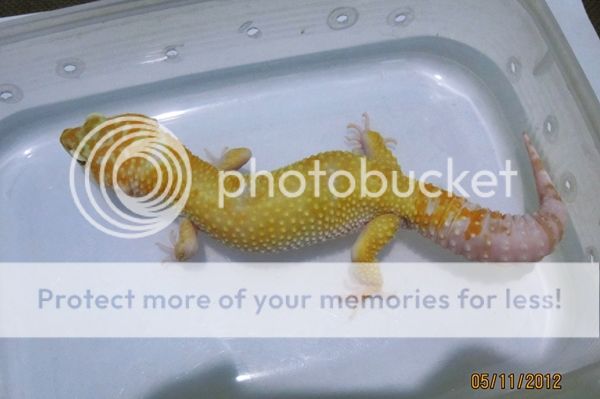
Follow the manufacturer’s guidelines for replacing the UVB light bulb. They continue to emit light long after the UV-emitting component “dies.”
If your Leopard Gecko doesn’t have access to UV light, buy reptile calcium powder with added Vitamin D3, but less than 25,000 IU/kg.
The amount can be found on the package’s label; it varies drastically from one brand to another.
You should dust all non-gut-loaded feeder insects with calcium powder and add calcium powder to gut-loaded insects every 2nd or 3rd day.
Baby Leopard Geckos also need a reptile multivitamin.
Dust their prey with the multivitamin powder once per week.
Your efforts to provide a balanced diet and proper care will substantially increase your leopard gecko’s lifespan and its quality of life.
Just pick up a new baby leopard gecko but have no idea how to name him/her? Click to see our top 70+ best leopard gecko names here.
How Much To Feed Leopard Geckos (Size And Frequency Table)
Are you confused about exactly what your leopard gecko needs in its diet?
Do you want to make sure your leopard gecko is getting enough to eat?
Diet is critical for all pets to live a long and healthy life, but leopard geckos have a different rule for eating than many other pets do.
It may not be evident for new owners, but we’re here to help with this guide to how much to feed a leopard gecko.
Leopard geckos need to eat every other day as adults and every day as juveniles and babies. They need to eat two appropriately-sized insects for every inch they are long.
Check out the rest of the article for more details.
Table of Contents
The Golden Rule: How Much To Feed A Leopard Gecko
Leopard gecko diet is based on different elements than many other reptile pets.
The “Golden Rule” of the leopard gecko diet contains three essential elements.
- Appropriately-sized insects
- 2 for every inch they are long
- Every other day for adults (around 1-year-old and above) and every day for juveniles and babies
Let’s unpack this.
Insect Size
Appropriately-sized insects are close in size to the distance between the reptile’s eyes but never larger.
The most common insects with leopard geckos are crickets and mealworms.
Learn more about what leopard geckos eat.
With young and small leopard geckos, not every common insect will work.
These are often too big.
Crickets are usually the best with this size of a gecko.
The geckos can expand their diet into other areas as they get bigger, including the popular dubia roach.
How Many Insects
The rule of 2 insects per inch long your pet is, is the hard and fast rule.
It’s not good to overfeed your pets (more on this later).
Measure the gecko from the nose to the base of the tail. Don’t measure the tail.
Don’t measure the tail.
A leopard gecko’s tail stores extra calories and fat, sure, but they’re also intended to fall off and wiggle when they’re being hunted.
For this reason, we don’t include the tail in our measurements.
After this, it’s simple to double the number of inches and get to what you need to feed your pet.
Worm Life Live Large 100 Gut-Loaded Superworms (2 inches)
View Price on Amazon
Deals on Chewy
We earn a commission if you click this link and make a purchase at no additional cost to you.
Frequency
Leopard geckos have two main numbers to look at when knowing how often to feed them.
Feed them one meal every day for leopard geckos under 1-year-old (considered juvenile or baby geckos).
At each meal, you feed them, as we discussed above.
For leopard geckos above 1-year-old (considered adults), feed them one meal every other day.
For more details, check out how often to feed a leopard gecko.
Age By Age: How Much To Feed A Leopard Gecko
With these ideas, you’ll know precisely what, when, and how much to feed your leopard gecko.
This chart covers frequency and amount based on age/size.
Remember, all insects must be close to but not larger than the distance between the leopard gecko’s eyes.
| Age/Size | Amount Of Insects | Frequency |
| Born/ 3″ inches | 6 insects | Every day |
| 1 month / 4″ inches | 8 insects | Every day |
| 3 months / 5″ inches | 10 insects | Every day |
| 6 months / 6″ inches | 12 insects | Every day |
| 9 months / 7″ inches | 14 insects | Every day/every other day (let the gecko tell you how much it wants to eat) |
| 1 year / 8″ inches | 16 insects | Every other day |
| 18 months/ 10″ inches | 20 insects | Every other day |
Note: The growth rate differs much based on gender, diet, humidity, light exposure, etc.
This is a generalization.
Can You Overfeed a Leopard Gecko?
Yes!
Remember the rule of 2 insects for every inch.
They shouldn’t be fed more than this unless you’re planning on breeding females OR after a female lays eggs.
Overfeeding makes the leopard gecko obese.
This puts pressure on the body’s functions and, just as with people, makes them more prone to health issues and shortens their lifespan.
This is extra dangerous if the gecko has lost its tail recently because there isn’t a place to store the extra fat and calories.
If you notice the gecko “pudging out,” lower the number of insects used by 3-5 (unless they’re under six months old) for a week.
On the other hand, if you notice the bones and ribs of the gecko showing through, but you’re still feeding them according to our recommended amount, you’ll need to check on the pet.
- Make sure the insects are close in size to the distance between their eyes.
- Look for changes in feces and get them checked for parasites.

How Should I Feed My Leopard Gecko?
Feeding a leopard gecko is easy!
These guys love live insects, so make sure you use live ones as much as possible.
Put 1-2 insects in the tank at a time and watch them hunt.
It’s OK and good for taming a leopard gecko to feed them by hand.
Keep your fingers on the end of the insect, and don’t jerk your hand away when the gecko bites at it.
Quick movements may startle the reptile, and in worst cases, make it drop its tail.
If your leopard gecko drops its tail, don’t panic and read our post on what to do when your leopard gecko drops its tail.
Continue adding 1-2 insects until you reach the recommended amount according to their size.
If they are reluctant to eat as you get close to the number, this is OK. Just let it be.
If they don’t eat much at all and are far from the recommended amount, it’s time to check your pet.
Those reptiles close to the 6-9 month mark in age may be transitioning to every other day feedings.
When you see signs of shedding, they won’t eat either. Look for paling skin and cloudy eyes.
When you see a consistent lack of appetite, they may be ill. So a trip to the vet is in order.
Conclusion
We hope you found this guide for how much to feed a leopard gecko helpful.
It may seem like a lot, but two insects for every inch is the standard for leopard geckos.
In the wild, these geckos are great insect hunters at the twilight times (dawn and dusk), which is also an active insect time.
But if you follow our recommendations, your pets are sure to live happy lives.
How to Care for a Baby Leopard Gecko (Beginner's Guide) - Pets
Video: Eublefar - Keeping a Gecko at HomeContents
- Leopard Gecko Facts
- Are Leopard Geckos Good Pets?
- Where can I get a baby leopard gecko?
- How much does it cost to own a leopard gecko?
- What kind of home does my baby leopard gecko need?
- What to feed a baby leopard gecko?
- How can I take care of my baby leopard gecko?
- How do I know if my baby leopard gecko is sick?
- Conclusion
While some people love cute pets like cats and dogs, others want something less complicated. Leopard geckos are one of those oddly adorable pets that are much easier to care for and, for some people, just as beneficial.
Leopard geckos are one of those oddly adorable pets that are much easier to care for and, for some people, just as beneficial.
If this is your first time adopting a baby leopard gecko, this guide is for you. Perhaps you are a happy new owner or trying to gather as much knowledge as you can before adopting one. Either way, we will provide you with everything you need to know about setting up a new home for leopard geckos, how to feed them, and how long they may need.
Leopard gecko facts
Leopard geckos belong to the genus Eublepharidae. Unlike most geckos, these wonderful creatures have movable eyelids but no toe pads like other species. This means that the leopard gecko cannot climb on smooth surfaces.
Don't be surprised if your leopard gecko sheds its skin frequently. For them, this is a positive and natural act. They shed their skin as a survival mechanism to prevent predators from catching their scent.
Leopard geckos inhabit the arid, semi-arid regions of the Middle East in countries such as Afghanistan, Iran, Iraq, and northern India. They are hardy reptiles and can live for over 20–30 years if properly cared for.
They are hardy reptiles and can live for over 20–30 years if properly cared for.
Leopard geckos are one of the few reptile species that are liked to be handled, especially if they have grown up around people and in contact with people. This, combined with their longevity, means you can have a cuddly reptilian friend for most of your adult life.
However, adopting a baby leopard gecko is not easy. Be prepared for a long journey to ensure your gecko has a good and stable life.
Are leopard geckos good pets?
Leopard geckos are considered young in their first year of life. They develop rapidly during this year. They can start breeding at around 12 months of age, but should not do so just yet to maintain their health.
Leopard geckos are generally considered among the best pets when it comes to reptiles. They are easy to care for and develop positive and affectionate relationships.
Leopard geckos are generally quite docile and happy creatures. In addition, they are one of the most beautiful geckos. The more you interact with them, the friendlier they will become as they age, but they don't need much of your time each day.
In addition, they are one of the most beautiful geckos. The more you interact with them, the friendlier they will become as they age, but they don't need much of your time each day.
Where can I get a baby leopard gecko?
You can buy leopard geckos at almost any pet store that sells reptiles. If there is no such pet store near you, you can also order them online or ask your local smaller pet store for help.
You can also find leopard geckos from a local breeder. Some people who have owned leopard geckos for a long time may also have accidentally bred them. It's worth doing a Google search in your area to see if anyone breeds them locally.
How much does it cost to own a leopard gecko?
The initial cost of adopting a leopard gecko cub will be between $30 and $100. Their price usually depends on their morph, color and pattern on the skin.
In addition to the leopard geckos themselves, you will also need to purchase a 10 to 20 gallon glass tank. You can also use plastic cages for very young, newly hatched geckos. However, it is best to give them a large aviary in which they can grow up so that they grow well.
You can also use plastic cages for very young, newly hatched geckos. However, it is best to give them a large aviary in which they can grow up so that they grow well.
You can get a new or used tank, which will significantly affect the price. They can range from $10 to $200 depending on quality and size.
You will also need a substrate for the bottom of the cage and a light to keep the environment warm. It will usually cost between $50 and $100. Lastly, you will need to feed them a regular insect diet, which can usually be purchased at any pet store.
Leopard gecko rations are usually not that expensive, ranging from $10 to $20 a week, especially if you buy them in bulk.
- Related reading: Why isn't your leopard gecko eating? 9possible solutions
What kind of home does my baby leopard gecko need?
A baby leopard gecko can have a small plastic cage to live in a smaller, less overwhelming space as they grow up in their first few months. However, this is not necessary if you want them to move into their final home.
However, this is not necessary if you want them to move into their final home.
The leopard gecko must have a glass terrarium. If you only have one, you can have a 10 gallon glass tank. However, if you think you will have multiple leopard geckos, you should choose a 15 to 20 gallon tank. It is most reasonable to mate leopard geckos of about the same age, as some adults will eat baby geckos.
You need to fill the tank with suitable substrate and habitat so that the gecko has something to hide and play under. There are all kinds of substrates that suit leopard geckos, including reptile carpet, which prevents them from digesting it when they try to catch their prey. You can also line the bottom of their enclosure with paper towels, tiles, or newspapers.
Avoid substrates such as small pebbles and sand, even if this may be what is found in their natural habitat. If mishandled, they can cause shock.
Lighting and heating are the most important aspects of a leopard gecko enclosure. They need a strict temperature regime so that they live a happy and long life. You can provide the necessary heating and lighting with a heating lamp. Don't forget to simulate day and night cycles of around 12 hours instead of leaving the lights on all the time.
They need a strict temperature regime so that they live a happy and long life. You can provide the necessary heating and lighting with a heating lamp. Don't forget to simulate day and night cycles of around 12 hours instead of leaving the lights on all the time.
As a general rule, the air temperature in the cage should be between 77 and 85 degrees Fahrenheit. The hot side of the reptile tank should be between 85 and 94 degrees and the cold side is about 70 degrees Fahrenheit.
To keep your leopard gecko comfortable and free, you should wear aquarium accessories. These include things like shelters and bathing platforms. You can also add small, non-poisonous plants and other natural supplements such as rocks.
What to feed a baby leopard gecko?
The leopard gecko eats a varied diet even as a child. You can feed a baby leopard gecko almost the same diet as an adult leopard gecko. They happily eat crickets and mealworms as staples. From there, you can diversify their diet by adding superheroes, wax worms, silkworms, and hornworms.
In addition to their normal diet, leopard geckos also need vitamin supplements after each meal. This is especially important for baby leopard geckos. Without this, they may not develop properly and will not have a strong skeleton.
Calcium deficiency is the first thing you should look for in a gecko's diet. Add calcium powder to their food and you have nothing to worry about.
How can I take care of my baby leopard gecko?
Leopard gecko babies need to be eaten every day. They grow rapidly during the first 6 months. After the first year of life, they need to be fed only every other day.
A good rule of thumb for how much to feed them is to give them two insects per meal for every inch of their length. It's best to do this later in the day because that's when they're most active.
In addition to feeding, you also need to know what they will lose every 5-7 days after hatching during the first month. After that, they will molt at least once every 1-2 weeks until they become adults.
You can tell that your baby leopard gecko is shedding because its coloration will become rather dull. After that, the skin separates and becomes white. Once it's gone, they won't waste the skin's nutrients and will eat it.
When it comes to handling a baby leopard gecko, you should wait at least 2 weeks before taming and handling it. They need to get used to their new home first.
Wait until baby gecko starts eating. Initial processing is carried out in stages. Let them get used to you by putting your hand in their aquarium in the evening, but do not try to touch them. Try to let them climb into your arms.
How do I know if my baby leopard gecko is sick?
Although leopard geckos are hardy, they are more vulnerable in infancy. Before you bring a baby leopard gecko into your home, you should learn how it can get sick if not cared for properly.
Calcium deficiency is the most dangerous possibility for a baby leopard gecko. You should feed the insects' intestines or sprinkle them with vitamin and mineral supplements so that the gecko can absorb everything they need to develop properly.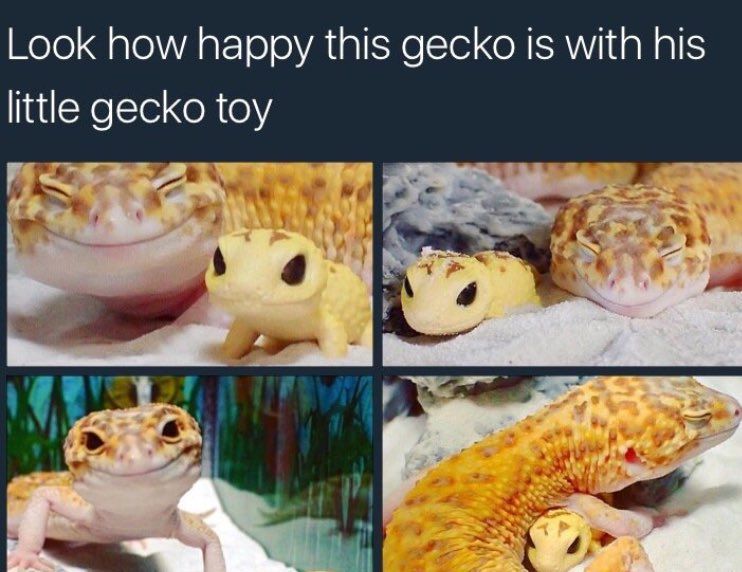
Another life-threatening disease that often occurs in baby geckos is damage to the gastrointestinal (GI) tract. Lizards accidentally eat bits of sand when they are hunting their insects. Gradually, this sand builds up in their gastrointestinal tract until it becomes clogged. Eventually, your pet will stop eating and will strain before defecation.
Another disease of baby geckos is delayed skin shedding. Instead of growing out of the skin, they become dehydrated and cannot shed their skin. This is usually due to lack of moisture. When they are unable to shed their skin, they rapidly lose weight, stop eating, and eventually die.
If you notice any of these symptoms, take your gecko to the veterinarian immediately. Most of them can be canceled up to a certain point. If left for too long, your gecko may die, and the result can happen surprisingly quickly.
Conclusion
Leopard gecko baby care requires training. However, once you understand this, you will have many happy years with an adorable pet who enjoys spending a lot of time with you.
Leopard eublefar: care and maintenance at home
Nevada 1976 Leopard eublefar: care and maintenance at home 0 Comment
Those who want to have an unusual pet at home, experts advise to pay attention to the leopard eublefar gecko. This lizard is suitable for both advanced reptile lovers and beginners. Caring for her is not difficult, and her character will not create problems: she is a peaceful and positive creature, easily attached to a person and able to show her love.
Origin and description
The leopard gecko (Eublepharis macularius) was described by the English zoologist Edward Blyth in 1854. The insectivorous lizard is native to Pakistan, Iran and Afghanistan. Lives in the desert, leads a nocturnal lifestyle. The leopard gecko is not listed as an endangered species.
Eublefar is a lizard with many spots or no spots at all, depending on the variant of this species. If several color variations of the leopard gecko with a typical pattern, as well as albinos, metel, mandarin and other popular varieties. Young geckos do not yet have spots, but they appear as they mature.
Young geckos do not yet have spots, but they appear as they mature.
Leopard geckos grow up to 20 cm long and weigh 150-220 grams. Care for lizards of any variety of this species requires the same. Leopard geckos live 5-7 years, and with good care up to 20 years.
Males can be distinguished from females by the protrusion at the base of the tail. In the female, this is one long bulge; in the male it is divided into two parts.
The head of the animal is large, pointed, connected to the body by a short thick neck. At the end of the snout is a pair of nostrils. There are large shields on the chin. On the sides of the head, openings of the auditory canals are visible, covered with eardrums.
The eyes of the lizard are large, oval and protruding, which is characteristic of nocturnal animals. Pupils in the form of a slit with a straight edge, located vertically. Unlike many geckos, the spotted leopard gecko has movable eyelids and a thin nictitating membrane. There are eyelash-like outgrowths at the back of the upper eyelid.
There are eyelash-like outgrowths at the back of the upper eyelid.
Mouth is voluminous, its corners are slightly turned up. For this, eublefar is often called the "smiling gecko." This "good mouth" is filled with 100 small teeth, which are designed to hold and chew prey for a short time. There are teeth on both jaws and are attached to the inside of the bone. This connection is fragile (pleurodont), so the teeth are alternately replaced with new ones every 3-4 months, while young growing teeth are next to the old ones.
The body of Spotted Leopard Gecko is covered with soft to the touch, but very durable leather. In nature, it protects the lizard from injury caused by grains of sand, sharp rocks, and dry clay. From above, the skin is covered with small scales, among which large cone-shaped scales stand out. These "warts" perform a thermoregulatory function. They contribute to the accumulation of heat and prevent its loss.
The body is thick and slightly flattened. Compared to the viviparous and agile lizard, the eublefar seems clumsy. He moves slowly, waddling from side to side.
Compared to the viviparous and agile lizard, the eublefar seems clumsy. He moves slowly, waddling from side to side.
Tail reptile thick in the middle, pointed, decorated with 2-3 lilac rings. It serves as a storage of adipose tissue. Since spotted leopard geckos live in arid areas, they use this reserve in the dry season as a source of water and in times of famine as nutrients. Lizards can discard the entire tail or part of it. This happens especially often with young individuals. From fear, pain, or to protect themselves from persecution, they have a contraction of special muscles, which contribute to autotomy.
Autotomy is the rejection by an animal of some limb or organ.
In young lizards, the tail grows quickly, in old lizards the regeneration process is delayed for a long time. The new tail will not be as long as it was before, but it will be thicker. It differs in color, the scales on it are smaller, and there are no tubercles.
If in nature the dropping of the tail occurs before wintering, then the animal is left without "strategic" reserves, it can get sick and even die. Usually geckos return to the place where they lost such a nutritious part of their body and eat it.
Legs of reptile of medium length, cylindrical, with five extended toes rounded at the end, devoid of "suction" pads. There are tubercles on the subdigital plates. All fingers of each paw are rounded, equipped with thin sharp claws that help the animal to climb vertical soft surfaces, such as branches and leaves.
There are no teeth (sand skis) along the edges of the fingers, which are characteristic of lizards living in deserts. The axillaries of the forelegs of the spotted leopard gecko are transformed into deep skin pockets, their purpose has not yet been clarified.
Young reptiles are yellowish or flesh-coloured with dark stripes on the body and a dark brown “cap” on the head. On the cap in the eye area and near the top of the head there is a light pattern that looks like a bird's track. By 8 months of life, eublefaras become adults, and then their color changes.
On the cap in the eye area and near the top of the head there is a light pattern that looks like a bird's track. By 8 months of life, eublefaras become adults, and then their color changes.
In mature animals, a pattern of brown spots is placed on a light gray or light yellow background, more saturated on the body. On the underside of the tail and head, the spots are less bright, and on the abdomen they are completely absent. The combination of numerous dark brown spots and light thin spaces between them creates a net pattern on the head. A light stripe, more or less free from spots, stretches along the spine. The belly of the leopard eublefar is pale pink, the sides are white.
And here is how sense organs work lizards:
- Leopard geckos have a well-developed hearing. It allows you to detect prey while hunting.
- Nocturnal animals see only black and white colors. But vision helps them remember the place of laying eggs and constantly return to it in order to leave new offspring.

- Eublefars have developed taste buds: animals distinguish sweet well, but are little sensitive to bitter.
- The sense of smell is less developed than other senses, but at a short distance geckos can search for objects by smell. Lizards can breathe freely even if there is food in their mouths, as reptiles have internal nostrils located near the pharynx. In addition, lizards have a vomeronasal organ, or Jacobson's organ, which is located in the upper palate. This is the peripheral part of the additional olfactory system of some vertebrates. Thanks to him, reptiles smell food in their mouths, as well as recognize the smells that surround them. To determine what is around, the lizard often sticks out its tongue, the signal from which enters the olfactory cavity (Jacobson's organ).
- There are suggestions that geckos navigate the Earth's magnetic field in the same way that birds can do it.
- Eublefars make hissing sounds when threatened.
Varieties of geckos
Today, there are five main types of such geckos:
-
- Iranian .
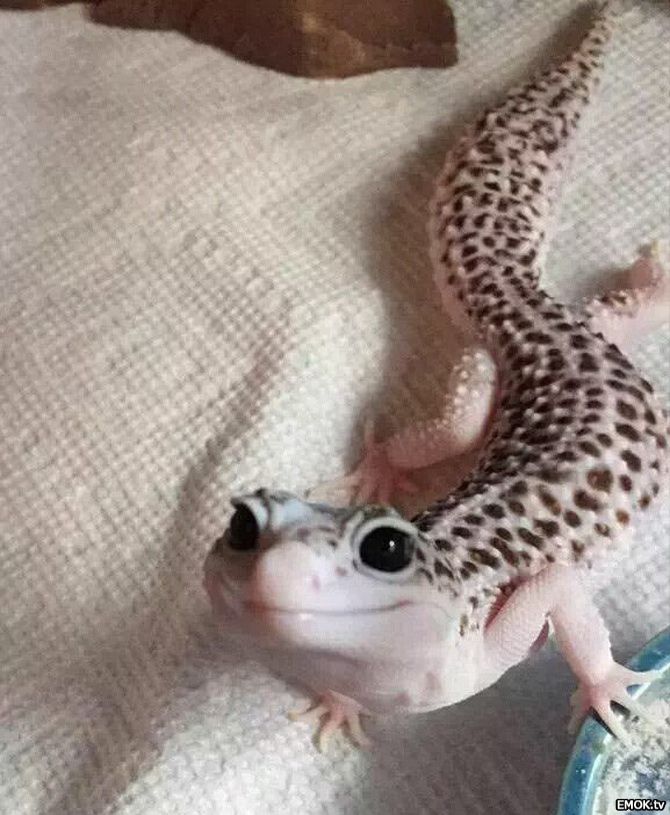 Lizards belonging to this species are the largest and have long legs.
Lizards belonging to this species are the largest and have long legs.
- Iranian .
-
- Hardwick . This type of eublefar is called East Indian spotted. So far, it has been poorly studied. Features include the presence of reddish-brown stripes on the back. In case of danger, such lizards make piercing sounds.
-
- Afghan . Some scientists do not distinguish these lizards as a separate species, but consider them a subspecies.
-
- Turkmen . Such eublefaras are listed in the Red Book, as they are on the verge of extinction. Features include the ability to create loud sounds and the presence of scales. On the tail and back of the reptile are yellow transverse stripes.
-
- Leopard . The most popular species for keeping at home, which has a spotted color.
TERRARIUM KEEPING
50 liters is enough for one gecko or a pair.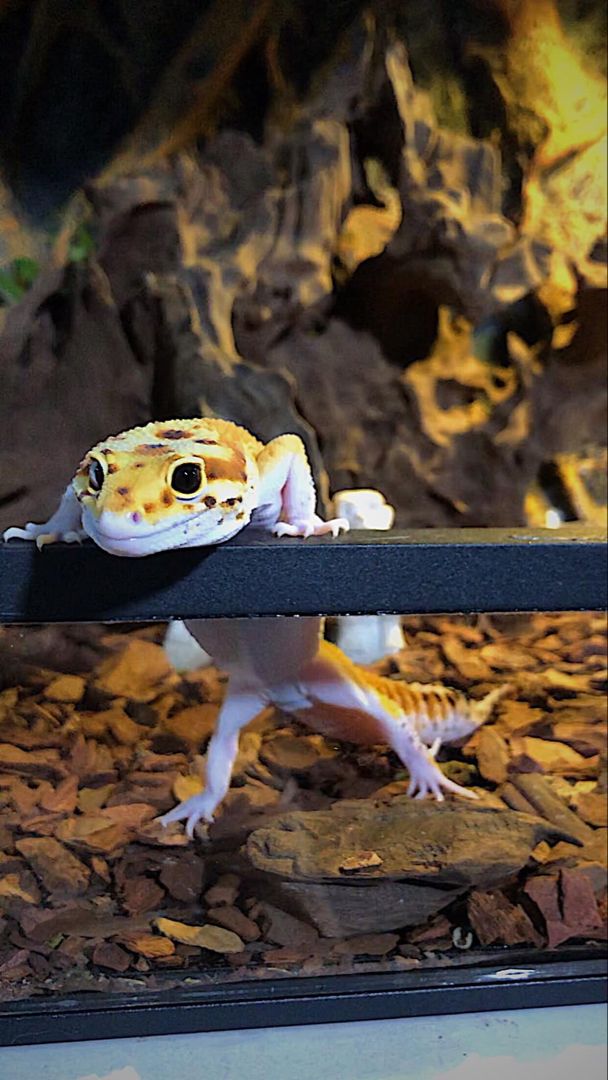 Of course, more volume will only be better, especially if you plan to breed them. You can not put a cover glass on the terrarium, since eublefars do not have the ability to climb on smooth surfaces, they do not have suction cups on their paws, like other types of geckos. However, if you have cats and dogs at home, then it is better to cover the terrarium, as they pose a serious danger to geckos. Well, do not forget that crickets and other insects can also escape from it, and you hardly need them in the house.
Of course, more volume will only be better, especially if you plan to breed them. You can not put a cover glass on the terrarium, since eublefars do not have the ability to climb on smooth surfaces, they do not have suction cups on their paws, like other types of geckos. However, if you have cats and dogs at home, then it is better to cover the terrarium, as they pose a serious danger to geckos. Well, do not forget that crickets and other insects can also escape from it, and you hardly need them in the house.
Several mature females will get along quite well (if they are about the same size), but males are pugnacious and will fight. A male and several females will also get along, but it is better not to keep them together until they have reached sexually mature sizes (about 45 grams for both male and female).
If you have purchased a young pair and plan to keep them together, it is better to grow them separately. Why? Males grow faster and are larger than females, especially when raised together. A larger male is more active and aggressive, he eats faster, often takes away food from the female, or simply terrorizes her. In addition, he becomes sexually mature earlier and begins mating games with a female, which is often not ready. Often, females weighing 25-30 grams lay eggs, but they are still too small. This shortens their lifespan, is stressful and reduces potential.
A larger male is more active and aggressive, he eats faster, often takes away food from the female, or simply terrorizes her. In addition, he becomes sexually mature earlier and begins mating games with a female, which is often not ready. Often, females weighing 25-30 grams lay eggs, but they are still too small. This shortens their lifespan, is stressful and reduces potential.
If you are raising several females together, remember that sometimes one of them grows faster and may take food from her companions. If the sizes are very different, then it is better to seat them in different terrariums.
What to feed the spotted eublefar?
In nature, "leopards" mainly prey on insects, but sometimes they can profit from their own kind, only smaller relatives. The favorite food of spotted eublefars at home is crickets (brownies, bananas, two-spotted). The Turkmen cockroach (Shelfordella tartara) has also proven itself as a food object, since it is very soft and easily reproduces without requiring special conditions. Eating it, eublefar even squints with pleasure. Not bad eaten marble (Nauphoeta cinerea) and larvae of Madagascar (Gromphadorhina portentosa) cockroaches.
Eating it, eublefar even squints with pleasure. Not bad eaten marble (Nauphoeta cinerea) and larvae of Madagascar (Gromphadorhina portentosa) cockroaches.
Mealworm (Tenebrio molitor) can also be included in the diet of geckos. Before serving insects, it is advisable to feed them with various greens, and then sprinkle them with vitamins for reptiles or calcium powder (this is especially important for females during the breeding season). Some individuals will not refuse newborn mice, but it is often not worth giving them. Do not forget that the gecko is still an insectivorous reptile. Spotted geckos do not eat various fruits, berries and other vegetation. Feeding a leopard gecko is very exciting.
It is advisable to present food to him from the hand or with tweezers: this way the reptile will receive its portion and will not swallow pebbles when hunting, and you will be sure that there are no cockroaches that could escape and lead a wild life in your apartment in the terrarium. Moreover, eublefar will be happy to accept the proposed food in this form. In addition, hand-feeding will speed up the process of taming the animal. "Hunting" for food, the gecko stands on outstretched paws and briefly taps its tail. In the summer, various orthopterans (Orthoptera) from the grasshopper (Tettigoniidae) and grasshopper (Acrididae) families can be caught in the lizard meadow. This should be done away from agricultural fields and gardens, as insects can be poisoned by pesticides.
Moreover, eublefar will be happy to accept the proposed food in this form. In addition, hand-feeding will speed up the process of taming the animal. "Hunting" for food, the gecko stands on outstretched paws and briefly taps its tail. In the summer, various orthopterans (Orthoptera) from the grasshopper (Tettigoniidae) and grasshopper (Acrididae) families can be caught in the lizard meadow. This should be done away from agricultural fields and gardens, as insects can be poisoned by pesticides.
If you feed grasshoppers, crush the head before feeding large ones, as grasshoppers have strong jaws that can injure your pet. Eublefars older than a year are fed 2-3 times a week. For one feeding, an adult gecko can eat an average of 5 crickets. The diet of young people is different. Very small geckos under the age of 1 month are fed 1-2 times a day - 1 cricket per feeding is enough for them. Lizards from 1 to 3 months old are fed once a day - they give 2 crickets. At the age of 3 to 6 months, geckos are fed every other day - an average of 1-3 large crickets per feeding. And for animals from six months to a year, it is enough to give food 2-3 times a week in the amount of 3-4 large crickets at a time. The terrarium must have a drinking bowl with water. It is good to use a Petri dish in this case, which has low edges. Water must be renewed at least every other day.
And for animals from six months to a year, it is enough to give food 2-3 times a week in the amount of 3-4 large crickets at a time. The terrarium must have a drinking bowl with water. It is good to use a Petri dish in this case, which has low edges. Water must be renewed at least every other day.
Heating
Eublefars are cold-blooded lizards and need warmth to digest their food. Bottom heating will be the best option for this. To do this, you can use a thermal cord, thermal mat or shoe dryers.
The temperature in the heating area must not exceed 32 degrees. It can be adjusted using a thermometer and the thickness of the soil when installing heating devices. Heating is placed in the corner of the terrarium, "heating" from 25 to 33 percent of the bottom area, while achieving a temperature gradient in the lizard's dwelling. At room temperature not lower than 22 degrees, heating can be turned off at night. Babies up to three months heating needs constant .
Shelters
The lizard's dwelling should have several shelters in warm and cold corners. And the eublefar will already make the choice of a more comfortable place. And also, do not forget about the necessary area of the terrarium - a wet chamber, which should be located in a warm corner where the animal will molt. She will be discussed a little later.
Inexpensive, practical and environmentally friendly shelters can be used , made from half a coconut, which have proven themselves well and are liked by zoublefar. And also it is not a problem to order decor or shelter from the master or do it yourself.
Soil
As the soil in the dwelling of the eublefar, an embankment is made of large pebbles and stones, but not sea and river ones, since they are slippery for the pet's paws. To prevent the animal from accidentally swallowing the pebbles, their size must be appropriate. It is advisable not to use ordinary sand, otherwise the eublefar will have digestive problems if it is swallowed.
Special carpets are very suitable for terrariums. It is safe, beautiful and convenient when cleaning the animal's home. Any soft doormat will also work fine. Babies should be kept exclusively on paper towels or napkins.
Water
Any low and small container will do. Eublefara lizards love to drink clean settled water , lapping it with their tongue like kittens. And also with pleasure they lick off droplets of fresh water and with daily spraying in the drinker there is no special need, although it will never be superfluous.
The drinker can be designed to match the style of a terrarium or make the simplest of improvised items. Alkaline water is considered the most beneficial in its composition.
Lighting
Eublefar gecko is a twilight animal and therefore does not need lighting. A regular 25-40 watt incandescent mirror lamp is quite suitable for it to simulate solar heating. Although the best option is the lower heating with a thermal mat, thermal stone or thermal cord.
Ultraviolet radiation is also a necessary element that ensures the synthesis of vitamin D 3 in an animal. For this, special ultraviolet lamps are used. Although, if you add the necessary vitamins and minerals to your pet's food and provide him with bottom heating, then he will not need a lamp emitting ultraviolet light. The fact is that the vitamin complex, combined with the correct thermal regime, provides the animal with vitamin D 3 to the fullest.
It is important to know that albino geckos do not like bright light. Therefore, when using lamps, this circumstance must be taken into account and, if possible, consult with an appropriate specialist.
Humidity
Humidity in pet's home must not exceed 50 percent. To increase the humidity to the desired value, if the apartment is too hot, it is necessary to periodically spray the soil in one corner of the terrarium, especially in the absence of a humid chamber.
The old skin of a domestic reptile must come off completely during molting and this process must be controlled, otherwise, under certain circumstances, the pet may stop hearing, be left without fingers, etc. Therefore, you need to know that adults molt within 1-2 months alone times, adolescents - 1 time in a two-week period. And this may not even be immediately noticeable, since the reptile eats the old skin after molting. Due to their rapid growth, babies shed much more often than their counterparts.
Breeding
If you can keep a male and females and have space to breed, you can get as many offspring as you have females. The main thing is to be able to attach this offspring.
It is very difficult to visually determine the sex of leopard geckos younger than 3-4 months. In adults 6-9 months old, it is quite easy to determine the sex. Males are usually slightly bulkier and have a broader head and neck than females. The male also has a pair of bulges behind the anus at the base of the tail. The female has no bulges.
The female has no bulges.
If you are not sure what gender your lizard is, add another lizard to the terrarium. If both geckos wag their tails from side to side, most likely they want to throw themselves at each other, which means they are two males.
It is recommended to take females for breeding who have reached a weight of at least 115 grams, but the larger the female, the better.
The mating process of reptiles is tough and one might even think that the male attacks the female. It nibbles on her tail and then slowly moves up her body until it reaches her neck.
A female spotted gecko lays one or two eggs at a time. To obtain predominantly females in the offspring, the incubation temperature should be 25-28C; for mixed offspring 29-32C; to obtain males 31-32.3C. Please note that the higher the incubation temperature, the more colorful the offspring will be, and the eggs will hatch faster. The incubation period is 46-60 days.
Young lizards will not eat until their first molt.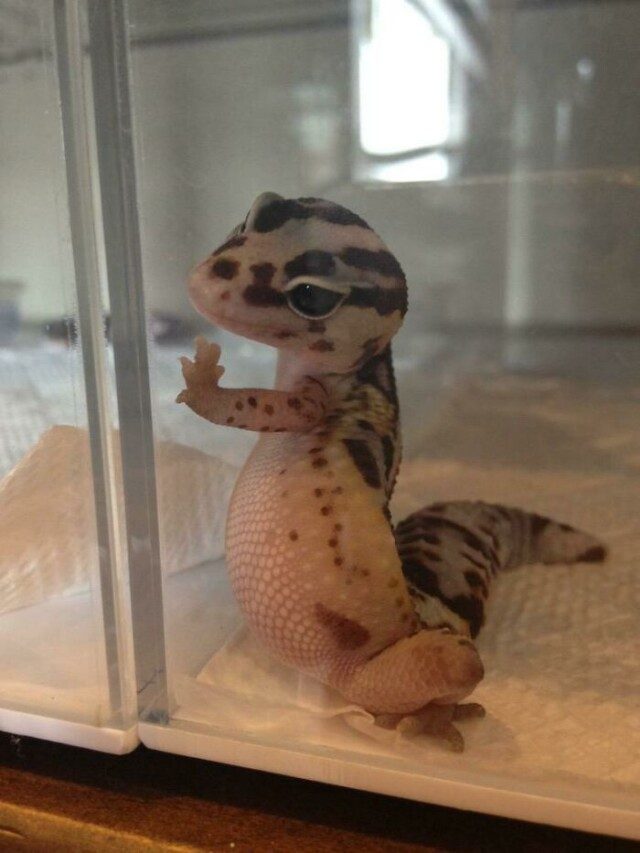 The gecko must eat the shed skin as it contains the vitamins and nutrients the lizard needs. After that, young monitor lizards begin to eat small, pinhead-sized crickets and small worms.
The gecko must eat the shed skin as it contains the vitamins and nutrients the lizard needs. After that, young monitor lizards begin to eat small, pinhead-sized crickets and small worms.
Diseases of geckos
With proper care, reptiles rarely get sick, but there is a list of diseases that can occur in such lizards. Pay attention to the behavior and condition of your pet in order to determine the presence of the disease in time and visit the veterinarian.
- Spotted leopard eublefar can suffer from rickets, which is characterized by curvature of the paws, and in the next stage the shape of the spine is already changing. With such a disease, coordination of movements is disturbed, and convulsions are observed.
- Cryptosporidiosis infection is dangerous and practically incurable. It is characterized by the following symptoms: a skinny tail, a black spot on the chest, indicating an enlarged liver, and watery spots, indicating the accumulation of a large amount of fluid in the abdominal cavity.

- Eublefar may suffer from parasites that infect lizards due to the fact that they eat living creatures. To avoid this, carry out prophylaxis using ReptiLife or Profender.
Gecko Vitamins
The most popular supplement for insectivorous reptiles is REPASHY Calcium Plus . It is a mixture of calcium, vitamins, proteins, fats, fiber and other important substances. When adding this complex, you can not use any other additives. REPASHY helps to increase the nutritional value of insects, and the reptile receives all the substances necessary for health. Leopard gecko must eat a supplement every day. It is necessary to put the insects in a bag, add the powder and shake everything well, and only then give food to the reptile.
Purchase selection rules
When purchasing a gecko, it is important to make sure that it is healthy. For this , you need to carefully examine it to check if it meets the following criteria:
- Juveniles and adults should have a thick, long, powerful tail.
 It is there that the lizard stores all the nutrients accumulated by the body. If the tail is not thick and long enough, this means that the animal's nutrition was poor, and the previous owner did not follow him well. This does not apply to small, newly hatched geckos that are actively growing.
It is there that the lizard stores all the nutrients accumulated by the body. If the tail is not thick and long enough, this means that the animal's nutrition was poor, and the previous owner did not follow him well. This does not apply to small, newly hatched geckos that are actively growing. - Gender can only be determined at the age of six months. Therefore, the second and subsequent geckos should be bought no earlier than this period, so as not to place several males in one terrarium.
- The abdomen must be fairly thick, but not bloated, otherwise illness or pregnancy may be suspected. Hanging sides speak of obesity.
- The lizard's behavior should be energetic - not lethargic and lethargic. She should not stagger when walking.
- The surface of the skin must be free of minor abrasions and scratches. Their presence indicates that the owner kept several males together.
It is worth remembering that a gecko acquired young may later change its color. Therefore, if the appearance of the eublefar is important, it is better to buy an adult.
Therefore, if the appearance of the eublefar is important, it is better to buy an adult.
How long does a spotted leopard gecko live?
The average life expectancy of a spotted leopard gecko in captivity is 12-15 years, the maximum is 20-25 years. Under natural conditions, the life span of males is 8-10 years, constantly giving offspring of females - 2-3 years, single females - 5-8 years.
Enemies of spotted eublefar in nature
Lizards have many enemies. They are hunted by many birds: storks, herons, buzzards, eagles, harriers, hawks, kestrels, secretaries, eagle owls, kites, owls, magpies, crows. No less terrible enemies are various snakes, many of which feed only on lizards. Mammals also feast on them: polecats, badgers, foxes, viverras, mongooses, hedgehogs, etc. Monitor lizards eat smaller lizards, including eublefars.
Reptiles flee from attack or freeze motionless, hiding. The latter tactic is especially effective against snakes that hunt only moving prey.






